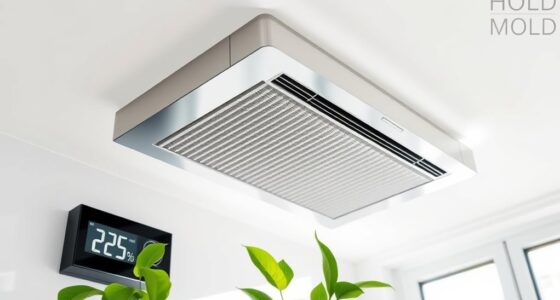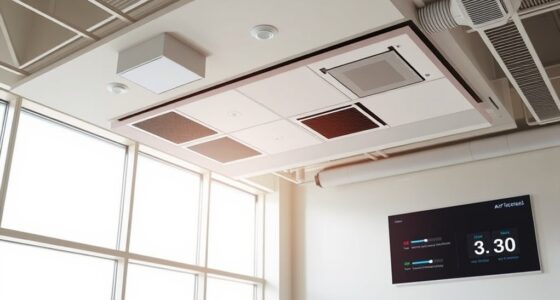Using CO2 and VOC sensors to control ventilation rates allows you to respond dynamically to indoor air quality changes. By integrating calibrated sensors with your building management system, you can automatically adjust airflow based on real-time pollutant levels. This helps maintain fresh air, reduce energy waste, and prevent under- or over-ventilation. If you want to discover how proper calibration and data integration enhance these systems, keep exploring the details below.
Key Takeaways
- CO2 sensors monitor indoor air levels to adjust ventilation, ensuring optimal air quality and energy efficiency.
- VOC sensors detect volatile organic compounds to trigger increased ventilation during high pollutant periods.
- Integrating sensor data with building management systems enables real-time, automated ventilation adjustments.
- Regular calibration of CO2 and VOC sensors maintains accuracy, preventing false readings that could disrupt ventilation control.
- Combining both sensor types provides comprehensive indoor air quality insights for smarter ventilation strategies.

Controlling ventilation rates effectively is essential for maintaining indoor air quality and energy efficiency, especially in occupied spaces. When you rely on CO2 and VOC sensors to manage ventilation, proper sensor calibration becomes a critical step. Without accurate calibration, these sensors can give false readings, leading to either under-ventilation or excessive airflow. Regularly calibrate your sensors to ensure they respond correctly to the specific indoor environment. This involves comparing sensor readings against known reference levels and adjusting the sensor output accordingly. Proper calibration helps you trust the data and make informed decisions about when to increase or decrease ventilation.
Proper sensor calibration ensures accurate readings for optimal ventilation control and indoor air quality.
Data integration plays a crucial role in optimizing ventilation control. When you connect CO2 and VOC sensors to your building management system, you create a seamless flow of real-time data that can be analyzed and acted upon instantly. Integrating sensor data allows your system to interpret multiple air quality indicators simultaneously, providing a complete picture of the indoor environment. This means you’re not relying on a single measurement but instead combining CO2 levels, VOC concentrations, and other relevant data points to determine the optimal ventilation rate. As a result, your system can automatically adjust airflow to maintain healthy indoor air quality while minimizing energy consumption.
Implementing data integration also enables you to set specific thresholds and rules based on your unique space requirements. For example, you might program the system to increase ventilation as CO2 levels rise above a certain point, indicating a higher occupancy. Similarly, VOC sensors can detect chemical emissions from cleaning products or equipment, prompting adjustments in ventilation to prevent indoor air pollution from building up. By systematically integrating these data streams, you avoid the pitfalls of reactive ventilation that responds too late or too little, creating a proactive approach to indoor air management.
Additionally, sensor calibration and data integration together improve system reliability and longevity. When sensors are properly calibrated, they provide consistent and accurate data over time. When this data is integrated into your control system, you can identify sensor drift or malfunction early, preventing incorrect ventilation adjustments. Regular maintenance and calibration checks, coupled with robust data integration, ensure your ventilation control remains precise and effective.
Ultimately, the combination of meticulous sensor calibration and seamless data integration allows you to strike a balance between healthy indoor air quality and energy efficiency. You gain a smarter, more responsive ventilation system that adapts to real-world conditions, reduces energy waste, and enhances occupant comfort. By prioritizing these aspects, you’re not just maintaining air quality—you’re creating a safer, more efficient indoor environment.
Frequently Asked Questions
How Do Sensor Placements Affect Ventilation Efficiency?
You should carefully consider sensor placement, as it directly impacts ventilation efficiency. Position sensors where airflow patterns naturally circulate air, avoiding dead zones or areas with poor circulation. Placing sensors too close to sources of CO2 or VOCs can give false readings, leading to over-ventilation. Proper placement guarantees accurate detection, allowing your ventilation system to respond effectively and maintain healthy air quality throughout the space.
Can Sensors Differentiate Between Various VOC Types?
You might wonder if VOC sensors can differentiate between various VOC types. While some advanced VOC sensors offer high specificity, many provide general readings without detailed discrimination. Sensor discrimination depends on their technology, with more sophisticated sensors capable of identifying specific compounds. However, most standard VOC sensors lack detailed specificity, so you should choose sensor types based on your need for VOC sensor discrimination and the level of detail required for your ventilation control.
What Maintenance Is Required for Long-Term Sensor Accuracy?
You should calibrate your sensors at least once a year to guarantee long-term accuracy, as their lifespan typically ranges from 5 to 10 years. Regular calibration compensates for sensor drift, which can cause inaccuracies over time. Additionally, keep sensors clean and check connections periodically. Proper maintenance ensures reliable readings, so your ventilation system responds appropriately, maintaining healthy indoor air quality and optimizing energy use.
Are There Specific Standards for Sensor Calibration?
Yes, there are specific standards for sensor calibration you should adhere to. You need to regularly calibrate your sensors according to manufacturer guidelines and guarantee they meet standard compliance such as ASTM or ISO standards. Proper calibration maintains accuracy over time and prevents drift. Keep a calibration log, use certified calibration gases, and verify sensor performance periodically to ensure consistent readings and reliable ventilation control.
How Do Outdoor Air Quality Fluctuations Impact Sensor Readings?
Outdoor air quality fluctuations can affect your sensor readings because indoor pollutant sources vary and influence sensor response time. When outdoor air quality worsens, sensors might detect higher CO2 or VOC levels, prompting increased ventilation. Conversely, improvements in outdoor air lead to lower readings. To manage this, you should calibrate sensors regularly and account for indoor sources, ensuring accurate readings despite outdoor fluctuations.
Conclusion
By using CO2 and VOC sensors to control ventilation, you can effectively maintain healthy indoor air quality. This approach challenges the theory that fixed ventilation rates are enough, showing instead that adaptive systems respond better to real-time conditions. When you rely on these sensors, you make certain that fresh air flows only when needed, saving energy and improving comfort. It’s a smart, evidence-backed way to create healthier indoor environments that truly meet your needs.










